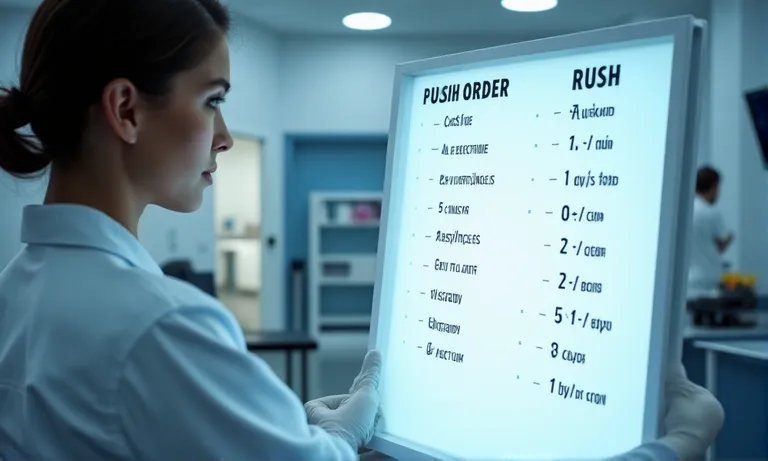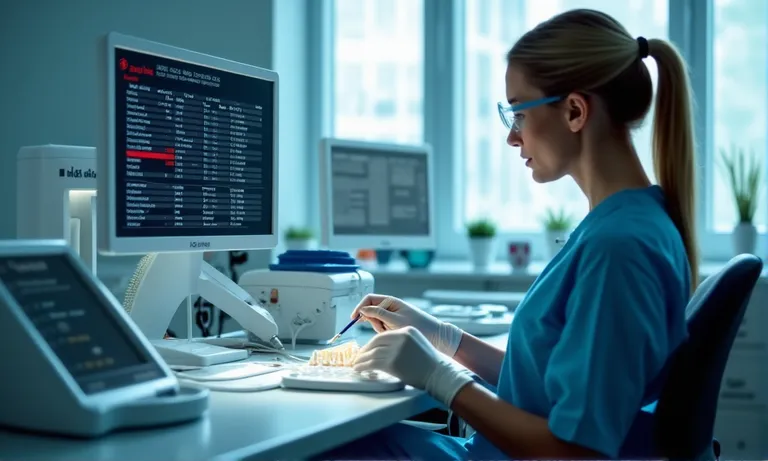Rush orders in crown & bridge workflows often arise from clinical urgency—but without clear coordination, they can turn into miscommunication and missed deadlines.
When labs lack defined rush handling systems or clients submit incomplete files, speed becomes risk rather than relief.
At Raytops Dental Lab, we help clinics manage time-sensitive cases with structured rush handling systems, priority workflows, and transparent escalation protocols to deliver faster—without cutting corners.
Dental labs handle rush orders through:
- Defined turnaround reductions for eligible case types (e.g., 2–3 days for digital single-unit crowns)
- Dedicated rush queues or technicians
- Encrypted express shipping with cutoff coordination
- Client-side labeling, file completeness, and advance confirmation
Structured rush protocols minimize delays without compromising quality.
How do labs define and accept rush orders in crown & bridge workflows?
Rush orders in crown & bridge workflows often arise from clinical urgency—but without clear coordination, they can turn into miscommunication and missed deadlines.
When labs lack defined rush handling systems or clients submit incomplete files, speed becomes risk rather than relief.
At Raytops Dental Lab, we help clinics manage time-sensitive cases with structured rush eligibility, priority workflows, and transparent escalation protocols to deliver faster—without cutting corners.

Dental-Lab-Rush-Order-Timeline-Chart
Typical turnaround vs. rush turnaround timelines
Rush cases compress production cycles—but only for suitable restorations. Labs usually define rush eligibility by turnaround savings without compromising quality.
- Standard single-unit zirconia: 4–6 working days
- Rush single-unit zirconia: 2–3 working days
- Standard 3-unit bridge: 7–9 days; rush typically not supported
- Layered esthetic or implant cases: rush rarely applicable due to process complexity
- Physical impressions add 1–2 days even under rush conditions
Common clinical indications for rush: temp sensitivity, insertion scheduling
Rush requests usually relate to time-sensitive clinical needs. Labs accommodate them better when the clinical rationale is clear and realistic.
- Immediate need due to provisional crown failure or dislodgement
- Patient has pre-booked insertion or travel constraints
- Cases coordinated with surgical timelines or re-prep
- Last-minute shade correction in pre-scheduled seatings
- Note: rush is not appropriate for non-urgent cosmetic refinements
Eligibility criteria for accepting rush orders by case type
Labs review several conditions before confirming a rush case. Not all restorations or submissions qualify.
- Case must be digital (STL), margin and bite scan complete
- Prescription must be clear (material, shade, delivery date marked)
- No layering or custom esthetics for same-day milling
- Lab must confirm calendar slot and production capacity
- Rush must be clearly marked in file name and Rx (“RUSH – Deliver by July 20”)
✅ Simple single-unit digital crowns are often eligible for rush – TRUE
With clean STL files and standard parameters, most labs can turn around such cases within 2–3 working days.
❌ Any restoration can be made urgent if the doctor requests it – FALSE
Not all restorations are technically or logistically suitable for expedited workflows—especially layered or implant cases.
What internal mechanisms prioritize rush cases without compromising quality?
Rush handling must be precise, not chaotic. Labs that manage rush orders effectively typically rely on structured internal systems—dedicated teams, digital flagging, and case-type restrictions—to accelerate output without compromising fit, function, or esthetics.

Image
ALT: Dental-Lab-Rush-Case-Management-System
Prompt:
A highly realistic, ultra-detailed, professional-quality image captured in a clean, well-lit dental lab. Lighting should be soft, diffused natural daylight with neutral white color temperature, avoiding cool or clinical blue tones. close-up at sunlight.
A technician works in a separate “rush case” workstation, with a labeled tray, digital screen showing flagged urgent cases, and a visible rush production calendar on the wall.
Separate technician team or production queue for rush
To prevent disruption of standard workflows, rush orders are often handled through a parallel pathway.
- Dedicated technicians focus solely on rush units during peak hours
- Separate “rush lane” in CAD design and milling ensures throughput
- Quality check stations for rush orders operate with tighter timeframes
- Limits per day maintain quality control under compressed schedules
Rush case tagging and flagging in lab systems
Digital lab management systems (LMS) help organize and track rush orders from intake to delivery.
- Rush cases flagged in LMS upon file upload or Rx entry
- Tags include deadline, case type, and clinician name
- Case status and expected out-date monitored in real time
- Auto-alerts trigger if case nears cutoff or hits a bottleneck
Limitations on case types or esthetic layering for urgent handling
Rush capacity is not universal—certain technical steps cannot be compressed without quality loss.
- Monolithic crowns (full-zirconia, PMMA) are rush-friendly
- Esthetic porcelain layering usually excluded from rush lane
- Implant-supported restorations need multi-stage design; rarely accepted as rush
- Any custom characterization or shade matching is deprioritized for speed
Well-managed labs don’t just “work faster”—they reroute resources with intention. If you rely on short lead times regularly, request our rush case SOP to see how we handle urgency with consistency.
What are the logistics options and risks for time-sensitive cases?
Even the fastest lab turnaround can be disrupted by poor shipping choices or unforeseen transit issues. To deliver time-sensitive cases reliably, both lab and clinic must align on logistics methods, time windows, and risk mitigation strategies.

Dental-Case-Shipping-Risks-Planning
Express shipping partners and cutoff time coordination
Not all express services offer the same guarantees, and daily cutoff times matter.
- Use integrated shipping with partners like DHL, FedEx, or UPS
- Confirm pickup cutoff (e.g., 3:00 PM lab time) to avoid 1-day delays
- Avoid “next-day” assumptions without location-specific validation
- For multi-case shipments, label each package clearly and avoid batching unrelated cases
Handling international zones, customs, and weekends
Cross-border rush orders are more complex due to time zone lags and border regulations.
- Add +1 day buffer for Asia-to-EU/US transit due to time shift
- Weekends and local holidays vary across countries—verify both sides
- Ensure customs declarations are accurate to avoid clearance holds
- Avoid shipping on Fridays for Monday-morning delivery expectations
Transport delays, insurance, and contingency rerouting
Even with careful planning, disruption may occur. Smart labs build in backup measures.
- Use insured shipping tiers for high-value or time-critical cases
- Have contingency couriers (e.g., local overnight services) in case of disruption
- Communicate proactively if weather events, strikes, or clearance delays are forecasted
- Share tracking with clinic as soon as dispatched
✅ Shipping method, time zone, and customs can affect delivery by several days – TRUE
Even with same-day dispatch, poorly planned shipping can cause 2–3 day delays that compromise patient schedules.
❌ All express services guarantee next-day delivery internationally – FALSE
No courier guarantees global next-day delivery across customs zones, especially during high-volume periods.
What should clients do when submitting rush orders?
A successful rush order depends not only on lab-side readiness, but also on the clarity and completeness of what the client provides. Well-prepared cases move faster with less risk of delay, especially when expectations and submission formats are aligned upfront.

Dental-Rush-Case-Client-Checklist
Mark STL and Rx clearly as “RUSH” and specify delivery deadline
File clarity is step one. If the urgency isn’t immediately visible, the case may be processed as routine.
- Label Rx as “RUSH – Deliver by [Date]” at the top
- Add “RUSH” in STL file names or folders (e.g.,
CLN1234_RUSH.stl) - Specify exact target delivery date, not vague terms like “ASAP”
- Align rush label with internal case ID or appointment date
Submit complete files: margin clarity, bite, photos, Rx in first upload
Partial uploads delay processing. All case components should arrive together, error-free.
- STL file must have visible margins and correct arch orientation
- Include bite registration (STL or IO scan) for articulation
- Upload all shade or intraoral photos upfront
- Ensure Rx includes material, shade, and any prep or special notes
Pre-confirm case eligibility and production calendar before submission
Before rushing to upload, confirm whether the case qualifies and the lab has the slot to take it.
- Check with your lab contact if the case type is rush-eligible
- Ask if capacity exists for your preferred delivery date
- Avoid submitting rush orders on weekends or before long holidays
- Understand surcharge or timeline limits for rush vs standard flow
Clients who communicate clearly and prepare cases thoroughly help rush orders succeed without friction. A well-organized submission can save days, not just hours.
How do labs handle remakes, delays, or escalation in urgent cases?
When a rush case goes wrong, recovery speed matters as much as the original production. A reliable lab should have dedicated systems to remake priority cases, communicate delays early, and offer clear escalation paths for time-sensitive issues.

Image
ALT: Dental-Rush-Case-Remake-Workflow
Prompt:
A highly realistic, ultra-detailed, professional-quality image captured in a clean, well-lit dental lab. Lighting should be soft, diffused natural daylight with neutral white color temperature, avoiding cool or clinical blue tones. close-up at sunlight.
A lab manager reviews a flagged remake request labeled “RUSH”, with a technician in the background adjusting settings on a digital milling machine. A priority case escalation board with response times is visible nearby.
Rush case remake prioritization and remake policy
In urgent workflows, remakes cannot wait in the standard queue. Labs typically triage these cases separately.
- Dedicated remake slots for rush cases within daily schedule
- Cases are re-entered into CAD/CAM workflow same day if files are usable
- If remake is due to lab-side error, surcharge is waived
- Rush remake cutoff (e.g., before 2:00 PM) for next-day shipping commitment
Communication timeline for delay notification
Proactive notice can give clinics a chance to reschedule or adjust. Silence is more damaging than delay.
- Labs notify clients immediately once a delay is known or suspected
- Email or portal messages include new delivery estimate and reason
- If remake is triggered, updated file or Rx request is sent promptly
- Clients receive follow-up confirmation once the revised case ships
Escalation paths: lab coordinator, account manager, or QA lead
Escalation should not be guesswork. Labs with defined points of contact offer smoother resolution.
- For rush cases, a dedicated rush coordinator or account manager responds directly
- Escalation matrix includes roles (CSR, production lead, QA head) with target response times
- Complex remakes involving esthetics or implants may be routed through case review panel
- Clients are provided with escalation contact info in onboarding or case pack insert
When something goes wrong with a rush order, the best labs don’t just react—they recover with structure. If your practice handles time-sensitive cases regularly, request our escalation protocol to see how we manage urgent disruptions from remake to resolution.
Conclusion
Handling rush orders requires more than working faster—it demands well-defined systems, mutual coordination, and readiness for exceptions. At Raytops Dental Lab, we support clinics managing tight timelines with controlled priority scheduling, dependable logistics, and fast-response channels that turn urgency into reliability.
- Labs should clarify rush turnaround timelines by case type and define eligibility for expedited handling.
- A capable lab will use internal production queues and digital flags to prioritize urgent cases without compromising accuracy.
- Shipping methods, cutoff windows, and international risks must be addressed upfront to avoid delays beyond production.
- Clients can prevent hold-ups by submitting complete, clearly marked rush cases and verifying lab capacity in advance.
- When issues arise, labs must prioritize rush remakes, communicate delays, and provide escalation paths with clarity and ownership.
If your clinic frequently manages urgent cases, connect with Raytops Dental Lab to explore our rush order protocol and escalation workflow.


